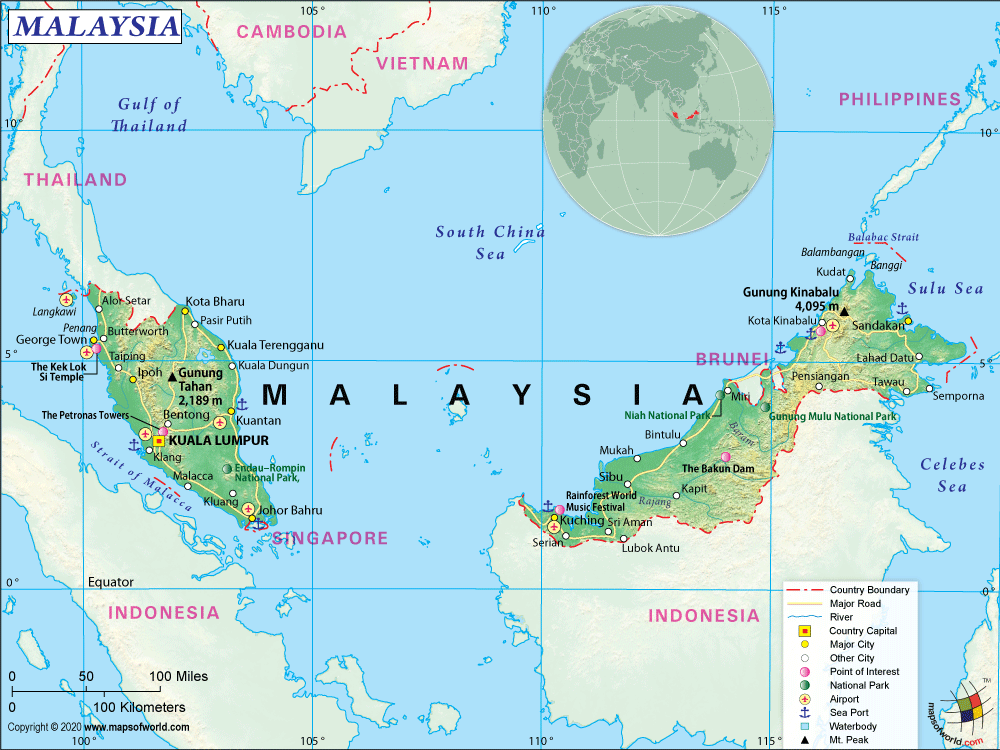Malaysia Map

- Malaysia States - Johor, Kedah, Kelantan, Kuala Lumpur, Labuan, Melaka, Negeri Sembilan, Pahang, Perak, Perlis, Pulau Pinang, Putrajaya, Sabah, Sarawak, Selangor, Terengganu
- Neighboring Countries - Singapore, Indonesia, Philippines
- Continent And Regions - Asia Map
- Other Malaysia Maps - Where is Malaysia, Malaysia Blank Map, Malaysia Road Map, Malaysia Rail Map, Malaysia River Map, Malaysia Cities Map, Malaysia Political Map, Malaysia Physical Map, Malaysia Flag
About Malaysia
Explore this Malaysia map to learn everything you want to know about this country. Learn about Malaysia location on the world map, official symbol, flag, geography, climate, postal/area/zip codes, time zones, etc. Check out Malaysia history, significant states, provinces/districts, & cities, most popular travel destinations and attractions, the capital city’s location, facts and trivia, and many more.
| Official Name | Malaysia |
| Capital | Kuala Lumpur |
| Population | 22.6 million (2001) |
| Area | 330,434 sq km or 127,581 sq km |
| Currency | Ringgit ($1=3.80) |
| Religion | Islam (official), Hinduism, Buddhism |
| Literacy | 83% |
| Languages | Malay (official), English, Chinese, Tamil |
| Major Cities | Ipoh, Johor Baharu, Melaka, Petaling Jaya |
| Climate | Hot and humid |
Malaysia was formed in 1963 through a federation of the former British colonies of Malaya and Singapore, including the East Malaysian states of Sabah and Sarawak on the northern coast of Borneo. But Malaya became independent in 1957 and Singapore’s separated in 1965.
Physical Map of Malaysia
Malaysia is divided into two regions, known as West Malaysia and East Malaysia. West Malaysia, also known as Peninsular Malaysia, consists of the southern portion of the Malay Peninsula and nearby islands. The coastal plains rise to hills and mountains.
Location of Malaysia
Malaysia is located in Southeastern Asia. Thailand borders West Malaysia on the north, and Singapore lies off the southern coastal tip.
East Malaysia occupies the northern section of Borneo Island, as well as offshore islands. East Malaysia also shares Borneo with Brunei, which lies on a small section of the northern coast, and also with the Kalimantan region of Indonesia, which lies to the south.
Climate of Malaysia
Except for the highlands, Malaysia’s climate is hot and humid round the year. Average daily temperatures vary from about 20° to 30°C and the average annual rainfall for the peninsula is about 2,500 mm. The exposed northern slopes of Sarawak and Sabah receive as much as 5,080 mm of rain per year.
Flag of Malaysia
The Malaysian flag contains 14 equal horizontal stripes of red (top) alternating with white (bottom); there is a blue rectangle in the upper hoist-side corner bearing a yellow crescent and a yellow fourteen-pointed star; the crescent and the star are traditional symbols of Islam; the design was based on the flag of the US.
Flora And Fauna of Malaysia
The flora of Malaysia spreads out to coastal mangrove forests in lowland tropical forests and at elevations over 3,900 ft, to mossy or mountain oak forests. The country is estimated to contain 8,000 species of flowering plants, including some 2,500 species of trees. Some of the most important commercial timber species like mahogany and teak are also found here. The world’s largest flower, the giant rafflesia (also known as corpse lily), and the largest of the pitcher plants, the Nepenthes rajah, which can hold up to 2 liters of water, grow here.
As far as fauna of Malaysia is concerned, the country has everything from Asian elephants to tigers to bears to rhinoceroses to some 500 species of birds to over a 100 species of snakes and 80 species of lizards to a huge collection of insects.
People of Malaysia
Malaysia has a multicultural society, with Malays, Chinese and Indians coexisting. The Malays who are Muslims and speak Bahasa are the largest community and are politically strong. The Chinese comprising about a third of the population are Buddhists and Taoists, and speak Hokkein, Hakka and Cantonese, and are dominant in business.
Indians accounting for about 10% of the population are mainly Hindu Tamils and speak Tamil, Malayalam, and some Hindi, and occupy larger towns on the west coast. There is also a sizeable Sikh community. Eurasians and indigenous tribes make up the remaining population. Despite Bahasa Malaysia being the official language, English is the connective element.
Arts, Culture and Music of Malaysia
Heavily influenced by Chinese and Islamic forms of music, Malaysian music is based largely around the gendang (drum), but also includes percussion instruments, flutes, trumpets and gongs. A strong tradition of dance and dance dramas is prevalent, some of which are of Thai, Indian and Portuguese.
origin. Other artistic forms include wayang kulit (shadow-puppets), silat (a stylized martial art) and crafts such as batik, weaving and silver and brass work.
Economy of Malaysia
Malaysia has emerged from being a producer of raw materials into an emerging multi-sector economy. The mainstay of the economy has been the export of electronics. Healthy foreign exchange reserves and relatively small external debt make it a healthy economy.
 Wall Maps
Wall Maps